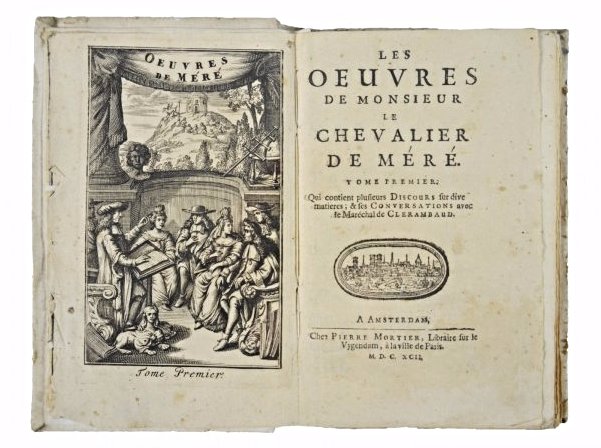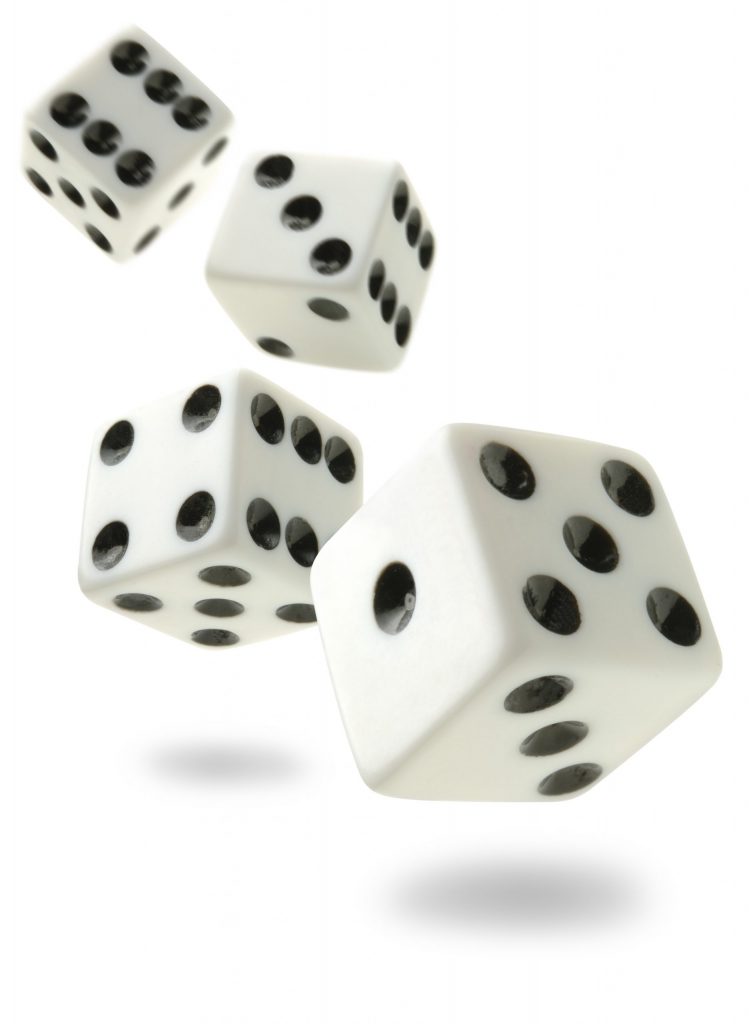1 Introduction
We are going to use a classic example in the history of probability: the problem posed by French gambler Antoine Gombaud (1607-1684), better known by his nome de plume “Chevalier De Méré”. By the way, he was not a nobleman, but just an amateur mathematician. Most important, for the history of mathematics and probability, he was an avid gambler.

Figure 1.1: Old manuscript with Antoine Gombaud’s texts
Specifically, let’s focus on one type of gambling scenario which we will refer to as “Game-A”
1.1 Description of Game-A
This is a fairly simple game of dice in which you roll a die four times, and you win if you get at least one six.

Figure 1.2: Rolling 4 dice in Game version A
Think about what could happen when rolling one die four times. For instance, some possible outcomes may be:
1, 3, 5, 2(you lose)2, 4, 6, 5(you win)5, 6, 3, 6(you win)4, 2, 1, 3(you lose)1, 3, 5, 2(you win)
This is how De Méré was reasoning about Game-A:
the chance of getting a six in one roll of a die is 1/6 (this is correct)
in four rolls of a die, the chance of getting one six would be \(4 \times 1/6 = 4/6 = 2/3\) (this is incorrect)
Based on this (incorrect) reasoning, he assumed that the odds were definitely in his favor. Interestingly, despite De Méré’s faulty reasoning about the probability of getting one six in four rolls, he was able to make money by playing this game.
Why was he able to make money? Let’s find out the probability of winning in this type of game.
1.2 Probability of winning Game-A
Finding the probability of winning Game-A translates into finding the probability of getting at least one six in four rolls of a (fair) die:
\[ Prob(\text{winning Game-A}) = Prob(\text{getting at least one 6 in four rolls}) \]
This probability can easily be calculated with the complement probability rule which states that:
the probability of one event is equal to 1 minus the probability of its complement event.
Or in symbols:
\[ Prob(\text{E}) = 1 - Prob(\text{Not E}) \]
and equivalently:
\[ Prob(\text{Not E}) = 1 - Prob(\text{E}) \]
where:
- \(\text{E}\) and \(\text{Not E}\) are complement events (i.e. they cannot occur simultaneously)
A classic example of this type of complement events is “E = getting heads when flipping a coin” and “Not E = getting tails when flipping a coin”.
\[ Prob(\text{getting heads}) = 1 - Prob(\text{getting tails}) \\ \text{and} \\ Prob(\text{getting tails}) = 1 - Prob(\text{getting heads}) \]
So, if we consider event “E = getting at least one six in four rolls”, then its complement event is “Not E = getting no six in four rolls”
1.2.1 No six in four rolls
The probability of getting no six in four rolls involves not getting a six in the first roll, AND not getting a six in the second roll, AND not getting a six in the third roll, AND not getting a six in the fourth roll. Because each roll is independent from the others, we can express this probability as the product of the probability in each roll:
\[ Prob(\text{no 6 in 4 rolls}) = Prob(\text{no 6 in 1st roll}) \times \dots \times Prob(\text{no 6 in 4th roll}) \]
In any single roll, the probability of getting no six is:
\[ Prob(\text{no six in one roll}) = \frac{5}{6} \]
Therefore:
\[\begin{align*} Prob(\text{no six in 4 rolls}) &= Prob(\text{no 6 in 1st roll}) \times \dots \times Prob(\text{no 6 in 4th roll}) \\ &= \frac{5}{6} \times \frac{5}{6} \times \frac{5}{6} \times \frac{5}{6} \\ &= \left( \frac{5}{6} \right)^4 \\ &= \frac{625}{1296} = 0.482253 \end{align*}\]
Consequently, the probability of winning Game-A is:
\[\begin{align*} Prob(\text{at least one six in 4 rolls}) &= 1 - Prob(\text{no six in 4 rolls}) \\ &= 1 - \left( \frac{5}{6} \right)^4 \\ &= 0.517747 \end{align*}\]
Note that this probability of 0.517747 is not that much different from 0.5 (just slightly greater). But the difference is enough so that if you gamble in this game, you should expect to have a positive gain … in the long run.